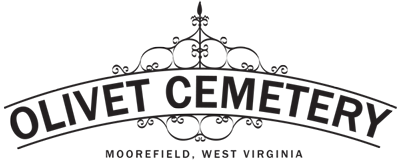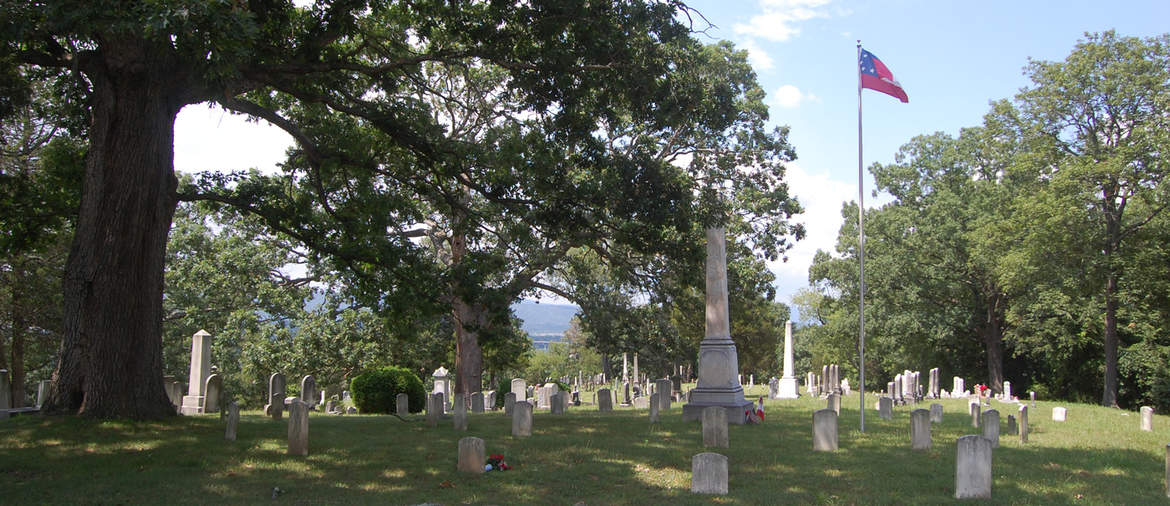Civil War History at Olivet Cemetery
The land that is now Olivet Cemetery was the scene of multiple engagements between Confederate and Union forces, many of which took place during 1863.
Recognizing the advantage of the elevated position of the hill, Federal forces dug protective trenches along the edges of the hill that overlooked both the South Branch and South Fork valleys as part of their artillery placements. A few remnants of these trenches remain, significantly reduced by more than 150 years of erosion.
In addition to the battles fought on the cemetery's land, many soldiers who fell in these battles, Union and Confederate, are buried here. The graves of several fallen Confederate soldiers are marked by a prominent monument located at the crest of the hill, with a ring of soldiers' graves surrounding it.
Please read more about the Civil War Trenches and Confederate Circle in the sections below. The selections are from the Olivet Walking Tour booklet, compiled by Elizabeth Wolfe Whitener in 1998, and last revised in 2002.
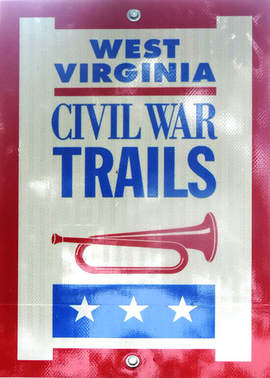

Civil War Trenches
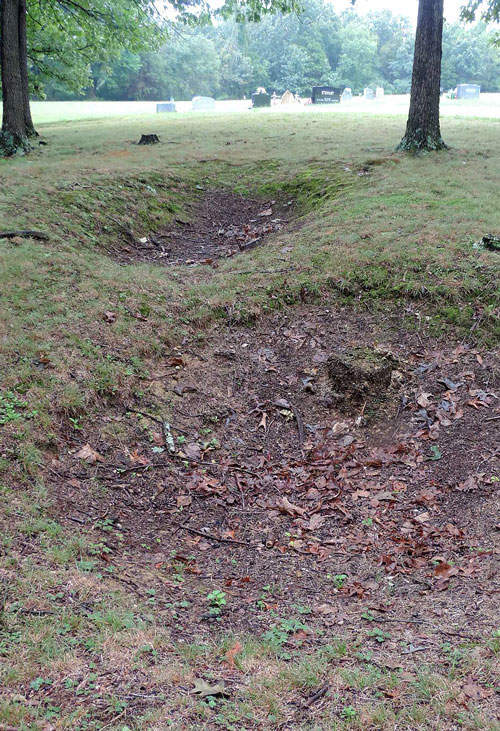
With the regular change of occupying forces of the Town during the Civil War, soldiers took a look around and determined that Cemetery Hill, now known as Olivet Cemetery, was an opportune location for the invading or attacking force.
A Hardy County Public Library archives collection of copies of letters contains the following account of one occasion of the shelling of Moorefield.
March 2, 1862
Dearest S,
"An attack was made on our town a short time since...
"Two cannon balls struck the Court House, one cannon the Lobb's house, his family there, and several others in different parts of town. Three minnie balls passed into Mrs. Emma By's house, she there. . . after the militia retired the town was taken possession of by the federal forces; who only remained a brief period...
"I witnessed the whole affair from a high knob known to you as Hickory,...
"Ellan"
It is most likely that Federal forces camping on Cemetery Hill had prepared trenches for their protection. Remnants of these trenches are still visible on the far northeastern slope of Olivet Cemetery. Other trenches said to have been in the western slope, facing Moorefield and along the edge of the hill where the toolshed now stands have given way to grassy knolls and burial sites.
Still in existence are at least three trenches used by the soldiers in that long ago rage as it swept the country. These trenches have been "out of thought" as have so many events that poisoned the relationships of so many people. Through the use of metal detectors, diggings, pasturing of cattle, and more, the trenches visible today are mere shadows of their former selves. As you approach and view them though, you will remember the sound of explosions meant to maim and kill, the dirt and grime, the fear, the frustration, and the challenge of the soldier.
Olivet Cemetery's Civil War trenches are located on the far northeastern slope of the Cemetery. Two smaller ones are adjacent and nearer the toolshed. They are somewhat oval in shape and approximately 20 feet on the long side. The third trench is located southeast of the first two and is of a semi-circular shape. It is approximately 60 feet from end-to-end.
Many shells, parts of shells and/or casings have been found around local battlefields, including Olivet Cemetery. Late in the evening soldiers continued to fire until prepared shots had been used since the dampness of the night and the dew of the morning made the powder unusable the following day.
These Civil War trenches atop Cemetery Hill are a sad reminder of that chapter of our history. The trenches were largely neglected until more recently when the Olivet Cemetery board of directors, with Grover See as president, began more extensive landscaping, paving, and planting, clearing and cleaning. In the interest of the preservation of this portion of our history, the trenches have been cleared with walking access to them. Further plans for their preservation remain in the hands of the Olivet Cemetery board of directors.
-- Compiled by Elizabeth Wolfe Whitener, 2002
Confederate Circle
Much of the following information is from The History of Hardy County, 1786-1986, by Richard K. MacMaster, 1986, page 236.
"Friends of Deceased Confederate Soldiers met at Moorefield on February 23, 1867. D. O. Maupin presided and A. H. McNeill acted as secretary. The ladies of the community had already formed a Memorial and Monument Association, with Mrs. Martha Ann VanMeter as president, Mrs. Catherine Price, Mrs. Rebecca Alexander, Mrs. A. R. Kuykendall, Mrs. Rebecca Kuykendall, and Miss Ann Kuykendall vice presidents, Mrs. F. B. Welton secretary and Mrs. Elizabeth McMechen treasurer. They appointed a committee of gentlemen to select suitable grounds in the cemetery for a monument and arrange for the reburial of the Confederate dead there.
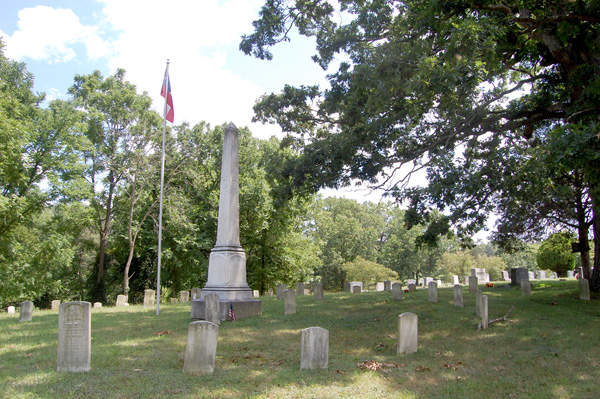 "They met again at the Moorefield Presbyterian Church in April 1867 and formally adopted a constitution. Mrs. E. M. McMechen was president, Mrs. Catherine Price vice-president, Mrs. Mary A. Kuykendall secretary, and Mrs. Mary C. Anderson treasurer. Five men formed the executive committee: G. T. Williams, P. T. Shearer, A. Hack, S. T. Tucker, and Colonel Abram Spangler. The Reverend G. W. White and the Reverend J. C. Dice agreed to compose a short address to be printed as a circular. The meeting appointed Mrs. Sallie Hack, Mrs. Sallie McNeill, Mrs. Sallie Miles, Mrs. Bell VanMeter, Miss Mary Maslin, Miss Mary Nelson, Miss Bettie Welton, Miss Maggie Chambers and Miss Sallie Heiskell to canvass for donations to the Confederate monument fund.
"They met again at the Moorefield Presbyterian Church in April 1867 and formally adopted a constitution. Mrs. E. M. McMechen was president, Mrs. Catherine Price vice-president, Mrs. Mary A. Kuykendall secretary, and Mrs. Mary C. Anderson treasurer. Five men formed the executive committee: G. T. Williams, P. T. Shearer, A. Hack, S. T. Tucker, and Colonel Abram Spangler. The Reverend G. W. White and the Reverend J. C. Dice agreed to compose a short address to be printed as a circular. The meeting appointed Mrs. Sallie Hack, Mrs. Sallie McNeill, Mrs. Sallie Miles, Mrs. Bell VanMeter, Miss Mary Maslin, Miss Mary Nelson, Miss Bettie Welton, Miss Maggie Chambers and Miss Sallie Heiskell to canvass for donations to the Confederate monument fund.
"As a result of their efforts a handsome granite monument was erected in the Mt. Olivet Cemetery overlooking Moorefield and Hardy County's Confederate dead encircled it. Each year on June 5, they arranged a memorial service and covered the graves of the Confederate dead with flowers."
This memorial service began in 1867 and continued into the 1920s. Today the First National Confederate Flag flies in honor of these Confederate soldiers. The flag was erected in 1998 by local Sons of Confederate Veterans.
Notice how the soldiers are identified. Those noted as "Strangers" were men who were not members of the involved unit. "Unknowns" were those soldiers who remained unidentified.
Men buried in the circle around the Confederate monument were killed in action. Other CSA veterans were buried outside the circle. CSA headstones/plaques were placed through efforts of United Daughters of the Confederacy.
-- Compiled by Elizabeth Wolfe Whitener, 2002
